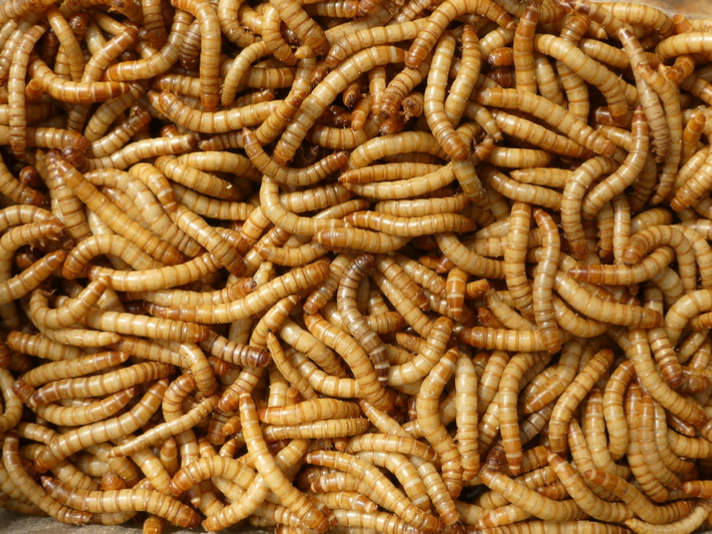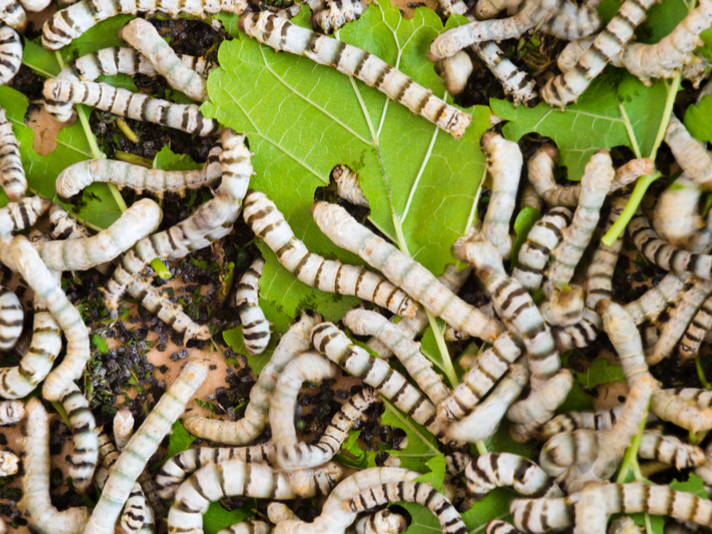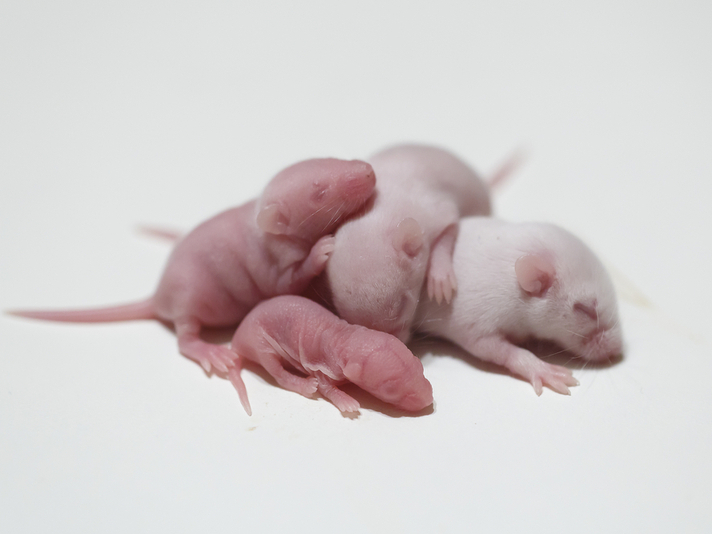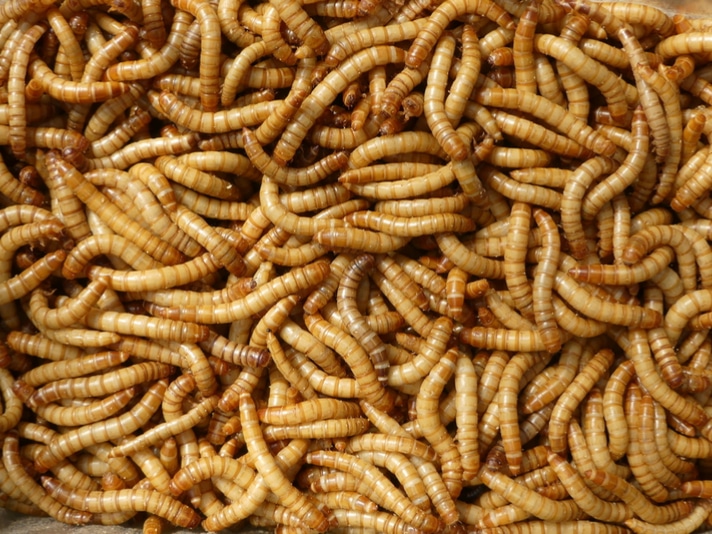There are a variety of food items for your herps ranging from crickets to mice to bananas.
There are many different types of food items to offer captive reptiles and amphibians. For smaller carnivorous lizards and amphibians, feeding them a varied diet that includes insects dusted with supplements, such as calcium and vitamins, goes a long way in promoting optimal health for your herps. For larger carnivorous reptiles, such as monitor lizards and snakes, rodents provide an appropriate staple. We will look at a variety of commonly available live food choices and explain how they influence your herps’ health and well-being.

IamJang/Shutterstock
Mealworms are a popular food for many reptiles.
Common Crickets as Reptile Food
Crickets provide an adequate dietary staple for smaller insectivorous herps. House crickets (Acheta domestica) can be purchased at most pet stores and from a variety of online sources. Although it can be more cost-effective to purchase crickets online in larger quantities and maintain them until you feed them to your pets, keeping them often presents new problems. Crickets escaping into the house or dying in large numbers due to disease can cause savings to quickly dissipate. Many herpkeepers find it more convenient to drive to their local pet store to purchase them.
We keep our crickets in 5-gallon buckets or small trash cans depending on their size. It is vitally important to keep these food items warm; crickets have a much lower survival rate if they are not maintained at a minimum of 75 degrees Fahrenheit. Temperatures should range from 75 to 95 degrees, but it is best to keep changes within that range as narrow as possible.
Read More
Exotic Insect Feeders For Your Herps
Several methods can achieve the appropriate temperatures. A low-wattage incandescent bulb or ceramic heat emitter can be suspended over the enclosure, but take care not to let the insects jump onto the heat source, which may facilitate escape or cause thermal burns. A digital thermometer can be used to find the optimal distance from the top of the enclosure to the heat source. Heat pads placed underneath the enclosure also maintain adequate temperatures.
Feeding crickets a proper diet is critically important both for the health of the crickets and for the animals eating them. Cricket diets can be purchased online and found at most pet stores. Adding squash, carrots, sweet potatoes and some mixed greens to this base diet is important for providing other nutrients and moisture. Offering fresh food items on a daily basis ensures the proper health of the crickets, and removing uneaten food items is helpful in reducing the odor associated with culturing crickets.
Chitinous Meals
Mealworms (Tenebrio molitor) are also a great food item for many insectivorous reptiles and amphibians. One mealworm contains several times the caloric content of a single cricket. Thus, feeding your herp mealworms helps to maintain its body mass.
One drawback of mealworms is their thick, chitinous exoskeleton. Secondary to the difficulty in digesting these insects, overfeeding mealworms often causes regurgitation in herp pets. Feed the worms to herps in moderation.
Mealworms can be purchased in bulk and are easily maintained in a 5-gallon bucket. The substrate should consist of wheat bran, and moisture can be provided in the form of potatoes, carrots and occasional leafy, green vegetables. Again, remove uneaten food items to reduce the smell associated with culturing these insects.
In the past 15 years or so, the king mealworm (Zoophobias spp.) has become a popular food item. These larger mealworms are popular because they are more conspicuous movers and often a more appropriate size for larger insectivorous reptiles.
Lowly Roaches
Several companies offer cockroaches for insectivorous herps. These insects are easily reared in plastic tubs, and most of them do not require substrate. Like crickets, cockroaches require warmer temperatures for optimal production. Keep them at temperatures around 75 degrees.
Many species of cockroaches, such as lobster roaches (Nauphoeta cinerea), can climb smooth surfaces, including glass, so extra precautions must be taken to ensure that the enclosure is escapeproof. Several products can be smeared along the top lip of the enclosure to prevent escape. Vaseline is the cheapest product to use. Simply place a 1- to 2-inch strip of Vaseline along the top of the enclosure.
A number of cockroach species do not climb glass. One such species is the orange-headed roach (Eublaberus posticus). Although this species does attain a larger size, the instars (the stage between molts) are of an appropriate size for many species of lizards and frogs.
Culturing cockroaches has significantly cut down on our monthly cricket bill, and despite our initial disgust at the thought of raising these insects in our home, they actually have a number of benefits over crickets. These benefits include decreased odor production, a reduced chitin-to-meat ratio, and in some cases more conspicuous movement.
Silky Wigglers
Silk moth larvae (Bombyx mori) can also be acquired via several online resources. Vendors typically have them at reptile expos, as well. Often called “silkworms,” they are raised on a nontoxic diet and are perfectly safe for use as a herp food item.

mimohe/shutterstock
Silkworms can be maintained on a diet of mulberry leaves.
Silkworms can be maintained on a diet of mulberry leaves, and a mulberry leaf powder can be reconstituted to feed the worms during the winter months.
A simple plastic container works well to maintain a group of these worms. Depending on how much they are fed and the temperatures at which they are maintained, these worms can grow very quickly and to a large size. Keep them at a temperature range between 70 and 85 degrees, and they will do well.
Mulberry leaves have a high mineral content, so silkworms make a nutritious food item and can be an excellent source of calcium. Easily reared, they are relatively inexpensive if raised from a small size or egg.
Tomato Honkers
Like silkworms, tomato hornworms (Manduca quinquemaculata) can be picked up from a variety of online sources. However, do not use wild-caught tomato hornworms because these may be toxic to your insectivorous herp. Only purchase these worms from a vendor where you can be assured they were raised on a nontoxic diet and are safe for your herps to eat.
Tomato hornworms are sold in large deli cups with the appropriate food. In this setup they grow quickly and thus must be used in a timely manner, usually within a few weeks.
Tomato hornworms weigh up to 12 grams, so they provide many more calories than crickets. These worms are especially helpful for reptiles and amphibians that need to put on a little weight, such as anorexic animals, those that have been ill and are recovering, or those that are ready for breeding.
Fuzzy Feeders
A rodent colony can be extremely helpful in reducing the cost of maintaining a large group of snakes or large carnivorous lizards. Like culturing feeder insects, rodent husbandry is very important in ensuring a healthy food item for your captive.

Mikhail Kochiev/Shutterstock
Pinky mice and rat pups.
The principle consideration when maintaining a rodent colony is cleanliness. Change the substrate at least once a week. Sometimes twice a week is better, such as during periods of heavy breeding.
Rodent breeding typically slows down during the winter months, which can present a problem if you are feeding reptiles and amphibians that are active year round. Plan accordingly and try to have a number of frozen food items during these months. You can purchase these or cull them from your livestock during periods of higher production.
Another consideration in rodent production is the frequency in which producing adult mice should be culled. Ideally, older mice should be fed to pets roughly every two to four months.
The final component to successful rodent maintenance is diet. Several companies manufacture rodent blocks specifically for mice, rats and other rodents. Although costly, these food items ensure proper nutrition. Many people use dog food made in part with plant matter as a rodent diet. Dog food is less expensive and provides rodents with an adequate source of nutrition, but laboratory diets are considered ideal. Provide clean water on a continual basis by using gravity-feed water bottles. Mice often defecate or urinate in a water bowl, so change it often. Just like gut loading crickets, a properly fed rodent provides nutrients to your herps for proper metabolism.
If you’re feeding adult mice to pets, it is often prudent to humanely kill mice before feeding them to snakes. This prevents feeders from harming the reptile and also reduces the amount of suffering by the food item.
Problem Feeders
Even if you have the correct food item for your captive reptile or amphibian, occasionally animals will refuse to eat in captivity. It may sound obvious, but certain species do not eat crickets or mealworms in the wild, and they may refuse to feed on these insects in captivity.
Research the animal you are keeping. Find out what time of day it normally eats. If you feed a nocturnal species in the morning, it is unlikely to eat. Conversely, if you feed a diurnal lizard at night, it is not likely to eat. Perhaps a hide area is necessary, so the animals feel a sense of security. Sometimes you can entice animals to eat by making their food smell like their desired prey.
Reptile Nutrition
During the past 10 to 15 years, a lot of advancements in reptile nutrition have been made. A number of new feeder insects have come into the hobby; new dietary supplements have been developed; and herpkeepers have a better understanding of ultraviolet light, vitamin D synthesis and calcium metabolism. It is our hope that the field of reptile nutrition will continue to advance and herpetoculturists will achieve greater longevity and better health in their captive reptiles.
Popular Reptiles and Their Food Items
California kingsnakes (Lampropeltis getula californiae): Unlike the kingsnakes L. zonata, L. pyromelana and L. alterna, the California kingsnake feeds well on mice. If the mice are offered a well-balanced diet, these snakes do very well feeding on them, and they can live well into their 20s.
Ball pythons (Python regius): With many beautiful morphs available, these snakes have become immensely popular during the past 20 years. Ball pythons do well on a rodent diet. Adults feed on rats, and young animals can be fed mice.
Green treefrogs (Hyla cinerea): These beautiful North American frogs do very well in captivity, and they make a great first pet for people who want to maintain a frog. Fed crickets and the occasional silkworm, they can live almost 20 years on this simple diet. Dust gut-loaded crickets with calcium before offering them to this frog.
Leopard geckos (Eublepharis macularis): These lizards do well on an insectivorous diet of crickets and king mealworms. Be sure to “supercharge” these food items by dusting them with calcium before offering them to the geckos.
Bearded dragons (Pogona vitticeps): These omnivorous lizards feed on a diet of greens, such as red leaf lettuce, kale and squash. Crickets and king mealworms can be added to supplement this diet, and the occasional pinky mouse is also appreciated by these animals.
Eastern box turtles (Terrapene carolina): These turtles make a good pet if provided with a wide variety of food items, including worms, insects, greens and fruit. Make sure to purchase one bred in captivity because they will be easier to feed. These turtles can live up to 30 years in captivity, so be prepared for that commitment.
Argentine horned frogs (Ceratophrys ornata): Also known as the Pac-Man frog, these natives of South America do well under captive conditions. They can be fed a base diet of crickets supplemented with the occasional king mealworm and pinky mouse. Overfeeding these frogs leads to obesity, so it should be avoided.
Crested geckos (Rhacodactylus ciliatus): These geckos enjoy a diet of insects and soft fruits, such as peaches, nectarines, mangos and bananas. Dust crickets with calcium to ensure they get the nutrients they need. Keep in mind that their jaws are not very powerful, so the more hard-bodied insects may not be appropriate.


